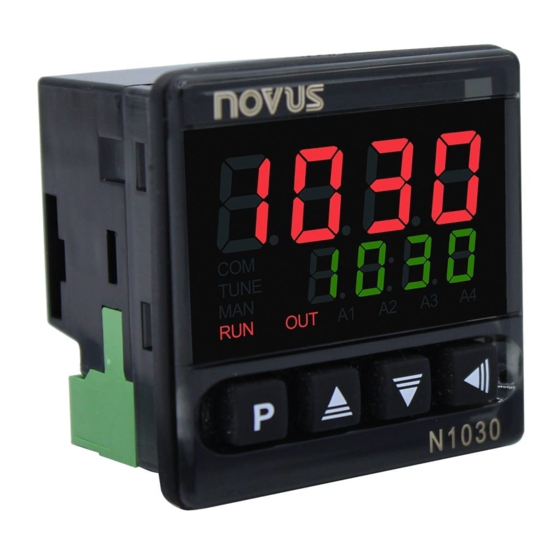
Advertisement
N1030T Controller
TEMPERATURE CONTROLLER AND TIME – INSTRUCTIONS MANUAL – V1.0x A
SAFETY ALERTS
The symbols below are used on the equipment and throughout this
document to draw the user's attention to important operational and
safety information.
CAUTION:
Read the manual thoroughly
before installing and operating
the equipment.
All safety related instructions that appear in the manual must be
observed to ensure personal safety and to prevent damage to either
the instrument or the system. If the instrument is used in a manner not
specified by the manufacturer, the protection provided by the
equipment may be impaired.
INSTALLATION / CONECTIONS
The controller must be fastened on a panel, following the sequence
of steps described below:
• Prepare a panel cut-out of 46 x 46 mm;
• Remove the mounting clamps from the controller;
• Insert the controller into the panel cut-out;
• Slide the mounting clamp from the rear to a firm grip at the panel.
RECOMMENDATIONS FOR THE INSTALLATION
• All electrical connections are made to the screw terminals at the
rear of the controller.
• To minimize the pick-up of electrical noise, the low voltage DC
connections and the sensor input wiring should be routed away
from high-current power conductors. If this is impractical, use
shielded cables. In general, keep cable lengths to a minimum.
• All electronic instruments must be powered by a clean mains
supply, proper for instrumentation.
• It is strongly recommended to apply RC'S FILTERS (noise
suppressor) to contactor coils, solenoids, etc. In any application it
is essential to consider what can happen when any part of the
system fails. The controller features by themselves can not
assure total protection.
ELECTRICAL CONNECTIONS
Fig. 01 below shows the electrical terminals of the controller:
Fig. 01 - Connections of the back panel
NOVUS AUTOMATION
CAUTION OR DANGER:
Electrical shock hazard
FEATURES
INPUT SINGNAL (INPUT)
The type of input to be used by the controller is defined in the
equipment configuration. Table 01 displays the input options
available to the user, one of which must be selected during the
controller configuration.
TYPE
CODE
Termocouple J
Tc j
Tc j
Range: -110.0 a 950.0 °C (-166.0 a 1742 °F)
Tc j
Tc j
Termocouple K
Range: -150.0 a 1370 °C (-238.0 a 2498 °F)
Tc k
Tc k
Tc k
Tc k
Termocouple T
Range: -160.0 a 400.0 °C (-256.0 a 752.0 °F)
Tc t
Tc t
Tc t
Tc t
Pt100
Range: -200.0 a 850.0 °C (-328.0 a 1562 °F)
Pt
Pt
Pt
Pt
Table 01 – Input types
The temperature sensor used should be the first information passed
onto the controller. A change in this parameter may imply automatic
changes to many other parameters. The user must check the general
condition of the configuration whenever an exchange of the sensor
type is held.
OUTPUTS
The controller offers two output channels: OUT1 and OUT2. Their
electrical characteristics are:
OUTPUT OUT1 - Logical pulse, 5 Vdc / 25 mA
OUTPUT OUT2 - Output Relay SPST-NA / 1,5 A / 240 Vac
The output channels are user configurable as Control Output,
Alarm Output or as Output Timers T1 or T2.
CONTROL OUTPUT ((TRL
(TRL)
(TRL
(TRL
The process control output can operate in ON/OFF mode or in PID
mode.
To operate in ON/OFF mode, the value defined in the parameter PB
should be 0.0.
With values other than zero in the PB
operates in the PID mode. The PID parameters can be automatically
determined enabling the auto-tuning function (ATvN
RANGE OF MEASUREMENT
PB parameter, the controller
PB
PB
ATvN).
ATvN
ATvN
PB
PB
PB
1/7
Advertisement
Table of Contents

Summary of Contents for Novus N1030T
- Page 1 N1030T Controller TEMPERATURE CONTROLLER AND TIME – INSTRUCTIONS MANUAL – V1.0x A SAFETY ALERTS FEATURES The symbols below are used on the equipment and throughout this INPUT SINGNAL (INPUT) document to draw the user’s attention to important operational and safety information.
- Page 2 The touch on is long, i.e. > 2 seconds, to disregard quick Min HH:MM. The intervals of T1 and T2 are presented in hours accidental touches. and minutes. NOVUS PRODUTOS ELETRÔNICOS LTDA.
-
Page 3: Operation
Each parameter is displayed with its prompt in the upper display and value/condition in the lower display. Depending on the level of parameter protection adopted, the parameter PASS PASS precedes the first parameter in the level where the PASS PASS protection becomes active. See section Configuration Protection. NOVUS PRODUTOS ELETRÔNICOS LTDA. -
Page 4: Configuration Protection
PV value indicated. protection strategy, limiting the access to particular levels, according to the table below. Spll Spll Spll Spll SP Low/High Limit. Defines the lower/upper limit for SP adjustment. Spxl Spxl Spxl Spxl NOVUS PRODUTOS ELETRÔNICOS LTDA. -
Page 5: Determination Of Pid Parameters
If the tuning does not result in a satisfactory control, refer to Table 05 for guidelines on how to correct the behavior of the process. Control output behavior after the T.e.(.o T.e.(.o T.e.(.o T.e.(.o interval T1 + T2. Time base for the timers T1 and tbas tbas tbas tbas NOVUS PRODUTOS ELETRÔNICOS LTDA. -
Page 6: Maintenance
Validate the calibration performed. Note: When checking the controller calibration with a Pt100 simulator, pay attention to the simulator minimum excitation current requirement, which may not be compatible with the 0.170 mA excitation current provided by the controller. NOVUS PRODUTOS ELETRÔNICOS LTDA. -
Page 7: Specifications
STARTS UP OPERATION: after 3 seconds connected to the power supply. CERTIFICATION: IDENTIFICATION Standard Model N1030T-PR Version with power supply 100~240 Vac 48~240 Vdc 24 V Model N1030T-PR-24V Version with power supply 12~24 Vdc / 24 Vac WARRANTY warranty conditions website www.novusautomation.com/warranty. NOVUS PRODUTOS ELETRÔNICOS LTDA.















Need help?
Do you have a question about the N1030T and is the answer not in the manual?
Questions and answers